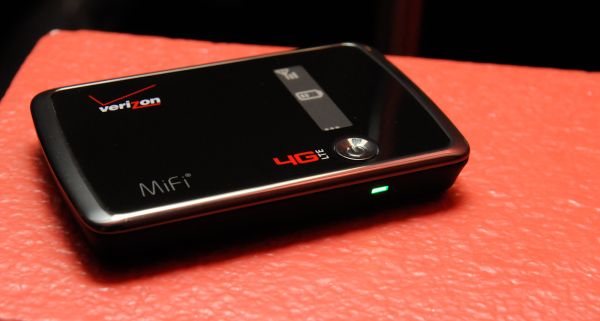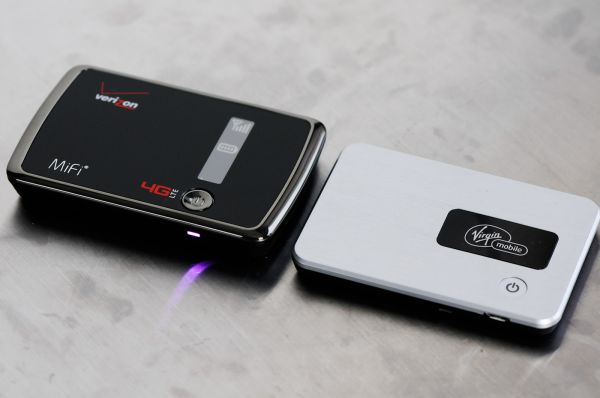Novatel Wireless MiFi 4510L Review - The Best 4G LTE WiFi Hotspot?
by Brian Klug on July 14, 2011 5:20 AM ESTBattery Life
One of the most important parts of the equation is how battery life compares both to the old MiFi 2200 product, the SCH-LC11, and the 4510L. Earlier I presented a table which included the actual battery sizes, note that the original 2200’s built in battery wasn’t all that large by today’s new standards, at 4.25 Whr. The 4510L comes with a 5.6 Whr battery which is very comparable in size to the one included by default with the SCH-LC11.
| Portable Hotspot Comparison | |||||||
| Novatel Wireless MiFi 2200 | Samsung SCH-LC11 | Novatel Wireless MiFi4510L | |||||
| Height | 59 mm (2.32") | 59 mm (2.32") | 60 mm (2.36") | ||||
| Width | 89 mm (3.50") | 90 mm (3.54") | 95 mm (3.74") | ||||
| Depth | 8.8 mm (0.35") | 11 mm (0.43") | 13 mm (0.53") | ||||
| Weight | 59 g (2.08 oz) | 81.5 g (2.87 oz) | 88.6 g (3.13 oz) | ||||
| Network Support | 800 / 1900 (1x/EvDO Rev.A/0) | 700 MHz (LTE), 800 / 1900 (1x/EvDO Rev.A/0) | 700 MHz (LTE), 800 / 1900 (1x/EvDO Rev.A/0) | ||||
| Battery Size | Removable 4.25 Whr | Removable 5.55 Whr | Removable 5.6 Whr | ||||
Our test consists of four tabs of our standard page loading suite, two of which include flash content. Each loads through a few dozen pages every ten or so seconds. In addition, we also stream a 128 kbps MP3 audio stream to keep everything active. It’s a rigorous test that simulates considerable (but not unreasonable) use.

The larger battery gives both newer 4G LTE hotspots an advantage over the old MiFi 2200, which used to get considerably warm as well. Unfortunately the 4510L comes in slightly behind the SCH-LC11, but the difference ends up being around 15 minutes rather than something substantial. This makes sense considering both have essentially the same reference design at their core and similar sized batteries. No doubt having more granular control over WLAN Tx power would help improve battery life, which at this point still seems excessive considering the device will likely always be within arms reach.
Conclusions and Final Thoughts
As of right now, both portable hotspots seem like the best way to use Verizon’s 4G LTE network if you’re interested in a data only connection. They’re still more reliable and less finicky than the USB modems, which upon last visit were still in need of more stable drivers. What’s more, you aren’t limited to using just one device with that route.
I guess that brings me to my current qualm with all of the 4G LTE hotspots - they’re both still limited to a rather arbitrary five users. If you go back, the concession always was that you could get unlimited data, but just a limited number of clients so you couldn’t completely abuse the connection. With unlimited data now a thing of the past on Verizon (which it always was for datacard plans on 4G LTE), it seems like the maximum client cap should go away - after all, you’re limited to a certain fixed amount of monthly bandwidth. The data plan pricing also seems exorbitant at this point. If it seems backwards that the price of data is going up at the same time as air interfaces are getting an order of magnitude faster, that’s probably because it is.
Even on the highest plan, that one day of 16 GB of streaming and testing would have cost $140 - $80 for the first 10 GB (the entire month’s bandwidth), then $60 for the 6 GB of overage. Couple that with the 4510L’s data counter that doesn’t survive reboots, and it isn’t hard to see things getting expensive quickly.
All said and done, I’m still looking for the perfect 4G LTE hotspot. The features that will win it for me are pretty basic - 5 GHz WLAN, device-as-modem, and some better web config pages that allow one to adjust WLAN power and better keep track of bandwidth. The 4510L isn’t very different from the SCH-LC11, and at this point it makes more sense to go for whichever is more affordable. That isn’t to say that the 4510L isn’t a good product, it just isn’t anything different from the already great SCH-LC11.












24 Comments
View All Comments
quiksilvr - Thursday, July 14, 2011 - link
Wouldn't it make sense to pay for speed instead? I guess the LTE network needs to be more widespread in order for this to work, but it just seems like a sick joke. Oh here's 10 Mbp/s, enjoy it for an hour a month!>:(
Brian Klug - Thursday, July 14, 2011 - link
That's actually *exactly* what AT&T's plans for LTE are. Part of their plan will involve QoS enforced speed tiers just like any other ISP. That was part of what was leaked a while back, you can see for yourself here: http://twitpic.com/5q42gxAlso speeds will be between 8-12 Mbps on AT&T's 700 / 1700 / 2100 MHz LTE deployment.
zanon - Thursday, July 14, 2011 - link
Of course it makes sense, on every network. Bandwidth caps and QoS tiers are what all connections should be, it's what actually is limited. Datacaps exist because it makes it easier to both milk people for more money, and to limit disruption to outdated existing technologies. Given the control concentrated into so few hands however it's very hard to see anyway to get this situation fixed.mlosee222 - Thursday, July 14, 2011 - link
Good review, you are spot on about the lack of configuration options in the web front end. My device is never further than arm's length and it would be great to turn down the wifi power. I actually learned how to write an android app specifically so I could keep track of my data usage and view connection stats on my phone without being logged in the browser interface. Its functional but the GUI is about as pretty as a linux shell.I don't have LTE in my area yet, although I got to use it a little bit in Vegas. In my experience the 45010L had trouble switching between 3G/4G and required a reboot to get the signal back. I did about five speed tests in Vegas; never broke 5mb and latency was never below 100ms.
LTE just went live in Salt Lake and my area *should* be getting it soon. The last couple weeks I've periodically seen phantom LTE signals with good stats (-60 dbm, 8 snr) but am so far unable to connect. I'm not sure if its a real signal or if the device is lying to me.
I actually use the 4510L exclusively for the data plan on my Nexus S. I don't mind carrying another device in my pocket since I get a data connection that actually works reliably. In my opinion, its a good idea to decouple the data connection from the phone. Tethering a PC is mandatory for my workload and I don't like the red tape carriers put in the way of using phones as a hotspot. That, and its nice to get LTE with a phone that has only an HSDPA antenna.
Overall I'm satisfied with the 4510L. I haven't really experienced LTE yet, although I'm tickled pink with the 3G connection alone. Then again, I'm just happy to get away from the stone-age, overloaded TMobile towers.
jrs77 - Thursday, July 14, 2011 - link
http://www.huaweidevice.com/worldwide/productFamil...The Huawei E5830 has all you want. It supports all bands, has a neat web-interface to configure it, has no sim-lock and supports USB-storage. Oh... and it's dirt-cheap for $80 and can connect up to 5 clients simulatanously.
dreddly - Thursday, July 14, 2011 - link
cool. this sounds like what I need. Our LTE is missing in CanadaBrian Klug - Thursday, July 14, 2011 - link
Maybe next we will check out one of these, I carry around a couple of Huawei modems for personal use that I've never really reviewed or anything. Their Mobile WiFi lineup seems to be gaining a lot of traction lately.-Brian
ggathagan - Friday, July 15, 2011 - link
But it doesn't list as a 4G/LTE deviceyelped - Thursday, July 14, 2011 - link
Sorry for being off-topic, but what's up with Anand's Evo 3D review? The self-evident answer is that he seems pretty busy lately.Thanks.
Brian Klug - Thursday, July 14, 2011 - link
He's working on it, just busy ;)-Brian